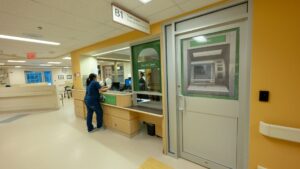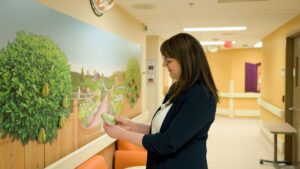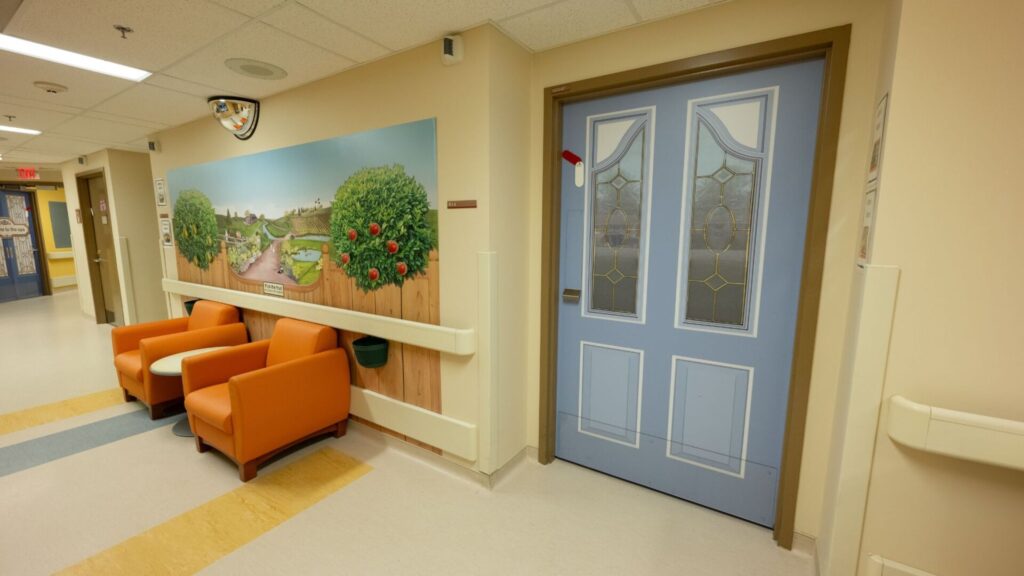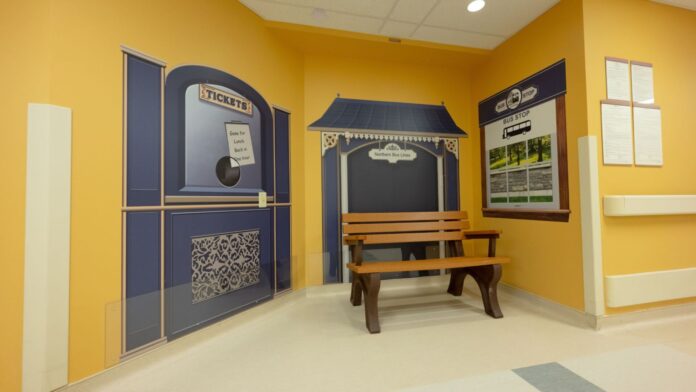
A project at the North Bay Regional Health Centre (NBRHC) is ‘raising the bar’ for care with people with neurocognitive disorders.
That from Dr. Rhea Galbraith, Care of the Elderly Physician at NBRHC, on the Dementia-Friendly Neighbourhoods project which has transformed the centre’s Evergreen, Willow, Cedar and Oak units.
“The goal is to create an environment that reflects a village because people don’t exist in hospital wards, people exist in our communities,” she says.
It includes thoughtful design changes and sensory features, like customized adhesive graphics for each patient’s door, areas dedicated to familiar places, exit concealing graphics, and interactive murals.

One includes an orchard with fruit on the wall that can be picked and examined.
There’s also a bus stop, a nursery, a bank where patients can withdraw ‘money’ that resembles Canadian currency, and a cafe where people can share time and a hot beverage with family and friends.
Dr. Galbraith says the transformation started in October last year and they’ve been tracking the positive results.
“We’ve had a reduction in Code Whites, which is where there is a patient incident requiring additional assistance and security, and we’ve reduced those incidents by 50%,” she says. “Other care interactions where there might be incident reports with staff and patients have also been reduced by 30 and 40%.”
Dr. Galbraith says when people have confusion from dementia and they see a door, they’re drawn towards it, try to leave and become distressed when they can’t.
She says adding graphics to the exits, which encourages patients to look at them and move on, is reducing the amount of distress on the unit.

“When we had one of the first adhesive graphics installed where it transformed a door into a bookshelf, the physio department on the other side of the door was used to hearing the door click and click all day long with patients rattling it,” she says. “Three hours after that decal was installed, they came over to check on the unit because they hadn’t heard any rattling there.”
The idea for the project was borne from The Hogeweyk – Dementia Village in the Netherlands and Dr. Galbraith says our hospital could very well be the first in Canada to undertake these changes.
“To my knowledge at this point there’s no other hospital in Canada that has created an actual space like a neighbourhood for older adults with dementia,” she says, adding a long-term care home in British Columbia is working on creating a village-like atmosphere for their residents.
“My hope is that this fantastic project in our hospital will be seen by other establishments, other long-term care homes, other hospitals and that collectively we can raise the bar, raise the standard of care for dementia in Canada,” Dr. Galbraith says.
She adds dementia is a life-limiting disease and she views this as palliative offering.
“We need to be mindful of respecting these people’s journey and ensuring that for some individuals if they’re in this environment they may be in the last years of their life that we make sure they’re good years and we provide the best standard of care that we can offer,” Dr. Galbraith says. “
Officials say the community came together to raise over $170,000, making the vision a reality.
Donors and hospital leaders celebrated the completion of the local project on Wednesday.
Listen to the audio reports here:







